My T. Thai
PAS : Prelim Attention Score for Detecting Object Hallucinations in Large Vision--Language Models
Nov 14, 2025Abstract:Large vision-language models (LVLMs) are powerful, yet they remain unreliable due to object hallucinations. In this work, we show that in many hallucinatory predictions the LVLM effectively ignores the image and instead relies on previously generated output (prelim) tokens to infer new objects. We quantify this behavior via the mutual information between the image and the predicted object conditioned on the prelim, demonstrating that weak image dependence strongly correlates with hallucination. Building on this finding, we introduce the Prelim Attention Score (PAS), a lightweight, training-free signal computed from attention weights over prelim tokens. PAS requires no additional forward passes and can be computed on the fly during inference. Exploiting this previously overlooked signal, PAS achieves state-of-the-art object-hallucination detection across multiple models and datasets, enabling real-time filtering and intervention.
Stochastic Primal-Dual Double Block-Coordinate for Two-way Partial AUC Maximization
May 28, 2025Abstract:Two-way partial AUC (TPAUC) is a critical performance metric for binary classification with imbalanced data, as it focuses on specific ranges of the true positive rate (TPR) and false positive rate (FPR). However, stochastic algorithms for TPAUC optimization remain under-explored, with existing methods either limited to approximated TPAUC loss functions or burdened by sub-optimal complexities. To overcome these limitations, we introduce two innovative stochastic primal-dual double block-coordinate algorithms for TPAUC maximization. These algorithms utilize stochastic block-coordinate updates for both the primal and dual variables, catering to both convex and non-convex settings. We provide theoretical convergence rate analyses, demonstrating significant improvements over prior approaches. Our experimental results, based on multiple benchmark datasets, validate the superior performance of our algorithms, showcasing faster convergence and better generalization. This work advances the state of the art in TPAUC optimization and offers practical tools for real-world machine learning applications.
Model Steering: Learning with a Reference Model Improves Generalization Bounds and Scaling Laws
May 13, 2025Abstract:This paper formalizes an emerging learning paradigm that uses a trained model as a reference to guide and enhance the training of a target model through strategic data selection or weighting, named $\textbf{model steering}$. While ad-hoc methods have been used in various contexts, including the training of large foundation models, its underlying principles remain insufficiently understood, leading to sub-optimal performance. In this work, we propose a theory-driven framework for model steering called $\textbf{DRRho risk minimization}$, which is rooted in Distributionally Robust Optimization (DRO). Through a generalization analysis, we provide theoretical insights into why this approach improves generalization and data efficiency compared to training without a reference model. To the best of our knowledge, this is the first time such theoretical insights are provided for the new learning paradigm, which significantly enhance our understanding and practice of model steering. Building on these insights and the connection between contrastive learning and DRO, we introduce a novel method for Contrastive Language-Image Pretraining (CLIP) with a reference model, termed DRRho-CLIP. Extensive experiments validate the theoretical insights, reveal a superior scaling law compared to CLIP without a reference model, and demonstrate its strength over existing heuristic approaches.
Swift Hydra: Self-Reinforcing Generative Framework for Anomaly Detection with Multiple Mamba Models
Mar 09, 2025



Abstract:Despite a plethora of anomaly detection models developed over the years, their ability to generalize to unseen anomalies remains an issue, particularly in critical systems. This paper aims to address this challenge by introducing Swift Hydra, a new framework for training an anomaly detection method based on generative AI and reinforcement learning (RL). Through featuring an RL policy that operates on the latent variables of a generative model, the framework synthesizes novel and diverse anomaly samples that are capable of bypassing a detection model. These generated synthetic samples are, in turn, used to augment the detection model, further improving its ability to handle challenging anomalies. Swift Hydra also incorporates Mamba models structured as a Mixture of Experts (MoE) to enable scalable adaptation of the number of Mamba experts based on data complexity, effectively capturing diverse feature distributions without increasing the model's inference time. Empirical evaluations on ADBench benchmark demonstrate that Swift Hydra outperforms other state-of-the-art anomaly detection models while maintaining a relatively short inference time. From these results, our research highlights a new and auspicious paradigm of integrating RL and generative AI for advancing anomaly detection.
Probabilistic Federated Prompt-Tuning with Non-IID and Imbalanced Data
Feb 27, 2025Abstract:Fine-tuning pre-trained models is a popular approach in machine learning for solving complex tasks with moderate data. However, fine-tuning the entire pre-trained model is ineffective in federated data scenarios where local data distributions are diversely skewed. To address this, we explore integrating federated learning with a more effective prompt-tuning method, optimizing for a small set of input prefixes to reprogram the pre-trained model's behavior. Our approach transforms federated learning into a distributed set modeling task, aggregating diverse sets of prompts to globally fine-tune the pre-trained model. We benchmark various baselines based on direct adaptations of existing federated model aggregation techniques and introduce a new probabilistic prompt aggregation method that substantially outperforms these baselines. Our reported results on a variety of computer vision datasets confirm that the proposed method is most effective to combat extreme data heterogeneity in federated learning.
NeurFlow: Interpreting Neural Networks through Neuron Groups and Functional Interactions
Feb 22, 2025
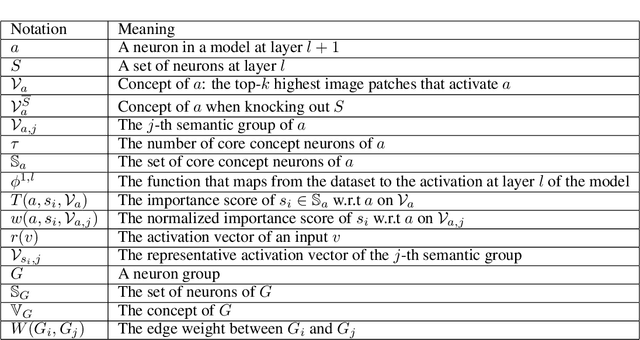

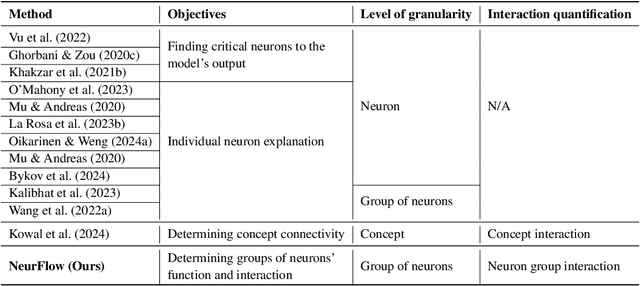
Abstract:Understanding the inner workings of neural networks is essential for enhancing model performance and interpretability. Current research predominantly focuses on examining the connection between individual neurons and the model's final predictions. Which suffers from challenges in interpreting the internal workings of the model, particularly when neurons encode multiple unrelated features. In this paper, we propose a novel framework that transitions the focus from analyzing individual neurons to investigating groups of neurons, shifting the emphasis from neuron-output relationships to functional interaction between neurons. Our automated framework, NeurFlow, first identifies core neurons and clusters them into groups based on shared functional relationships, enabling a more coherent and interpretable view of the network's internal processes. This approach facilitates the construction of a hierarchical circuit representing neuron interactions across layers, thus improving interpretability while reducing computational costs. Our extensive empirical studies validate the fidelity of our proposed NeurFlow. Additionally, we showcase its utility in practical applications such as image debugging and automatic concept labeling, thereby highlighting its potential to advance the field of neural network explainability.
LLM-assisted Concept Discovery: Automatically Identifying and Explaining Neuron Functions
Jun 12, 2024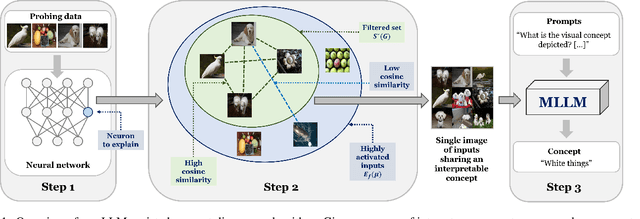

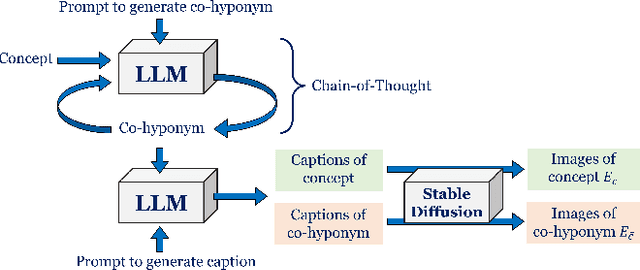
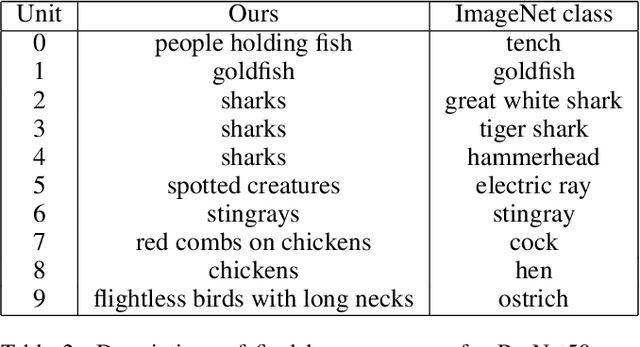
Abstract:Providing textual concept-based explanations for neurons in deep neural networks (DNNs) is of importance in understanding how a DNN model works. Prior works have associated concepts with neurons based on examples of concepts or a pre-defined set of concepts, thus limiting possible explanations to what the user expects, especially in discovering new concepts. Furthermore, defining the set of concepts requires manual work from the user, either by directly specifying them or collecting examples. To overcome these, we propose to leverage multimodal large language models for automatic and open-ended concept discovery. We show that, without a restricted set of pre-defined concepts, our method gives rise to novel interpretable concepts that are more faithful to the model's behavior. To quantify this, we validate each concept by generating examples and counterexamples and evaluating the neuron's response on this new set of images. Collectively, our method can discover concepts and simultaneously validate them, providing a credible automated tool to explain deep neural networks.
CHARME: A chain-based reinforcement learning approach for the minor embedding problem
Jun 11, 2024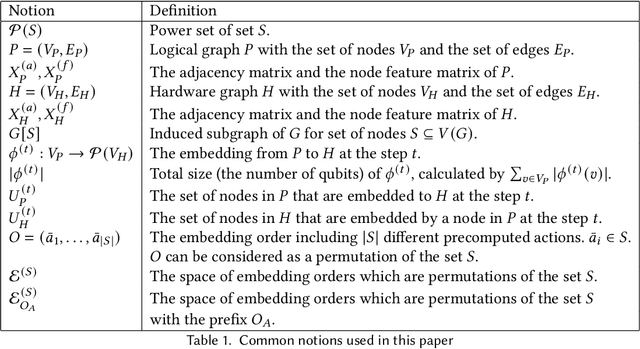
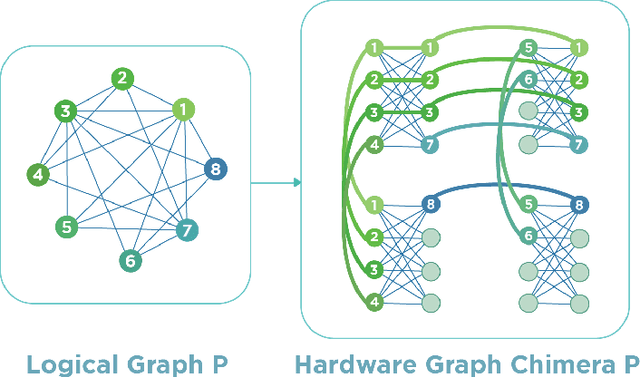
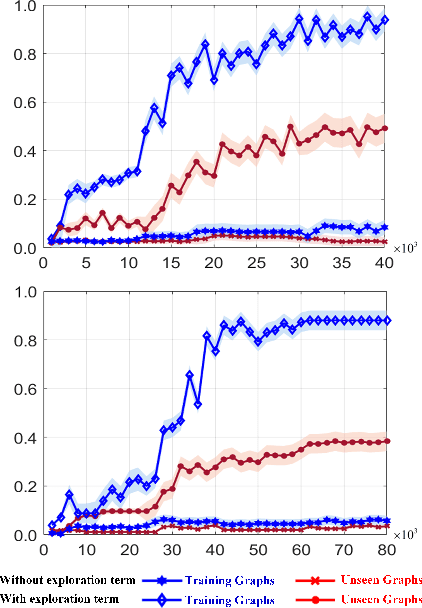

Abstract:Quantum Annealing (QA) holds great potential for solving combinatorial optimization problems efficiently. However, the effectiveness of QA algorithms heavily relies on the embedding of problem instances, represented as logical graphs, into the quantum unit processing (QPU) whose topology is in form of a limited connectivity graph, known as the minor embedding Problem. Existing methods for the minor embedding problem suffer from scalability issues when confronted with larger problem sizes. In this paper, we propose a novel approach utilizing Reinforcement Learning (RL) techniques to address the minor embedding problem, named CHARME. CHARME includes three key components: a Graph Neural Network (GNN) architecture for policy modeling, a state transition algorithm ensuring solution validity, and an order exploration strategy for effective training. Through comprehensive experiments on synthetic and real-world instances, we demonstrate that the efficiency of our proposed order exploration strategy as well as our proposed RL framework, CHARME. In details, CHARME yields superior solutions compared to fast embedding methods such as Minorminer and ATOM. Moreover, our method surpasses the OCT-based approach, known for its slower runtime but high-quality solutions, in several cases. In addition, our proposed exploration enhances the efficiency of the training of the CHARME framework by providing better solutions compared to the greedy strategy.
MIM-Reasoner: Learning with Theoretical Guarantees for Multiplex Influence Maximization
Mar 10, 2024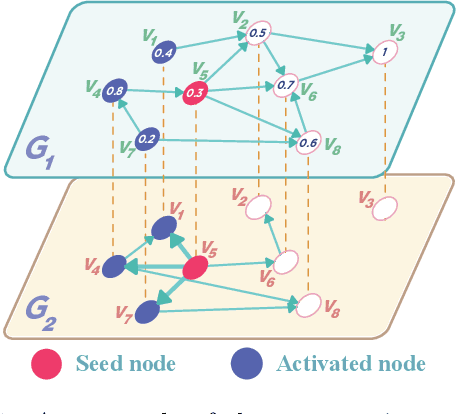

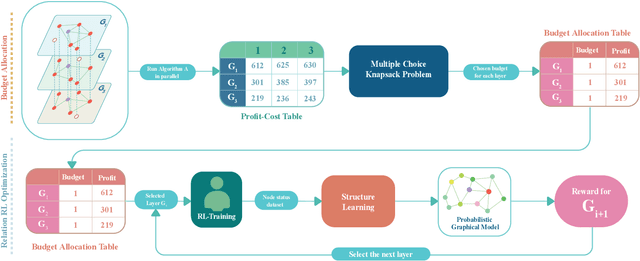
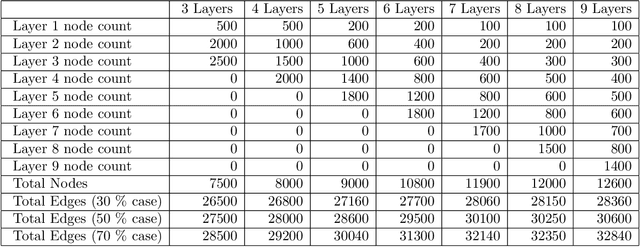
Abstract:Multiplex influence maximization (MIM) asks us to identify a set of seed users such as to maximize the expected number of influenced users in a multiplex network. MIM has been one of central research topics, especially in nowadays social networking landscape where users participate in multiple online social networks (OSNs) and their influences can propagate among several OSNs simultaneously. Although there exist a couple combinatorial algorithms to MIM, learning-based solutions have been desired due to its generalization ability to heterogeneous networks and their diversified propagation characteristics. In this paper, we introduce MIM-Reasoner, coupling reinforcement learning with probabilistic graphical model, which effectively captures the complex propagation process within and between layers of a given multiplex network, thereby tackling the most challenging problem in MIM. We establish a theoretical guarantee for MIM-Reasoner as well as conduct extensive analyses on both synthetic and real-world datasets to validate our MIM-Reasoner's performance.
Analysis of Privacy Leakage in Federated Large Language Models
Mar 02, 2024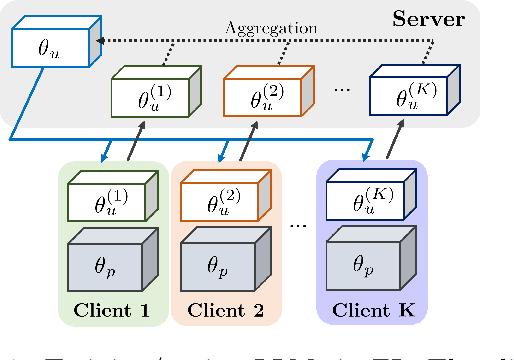

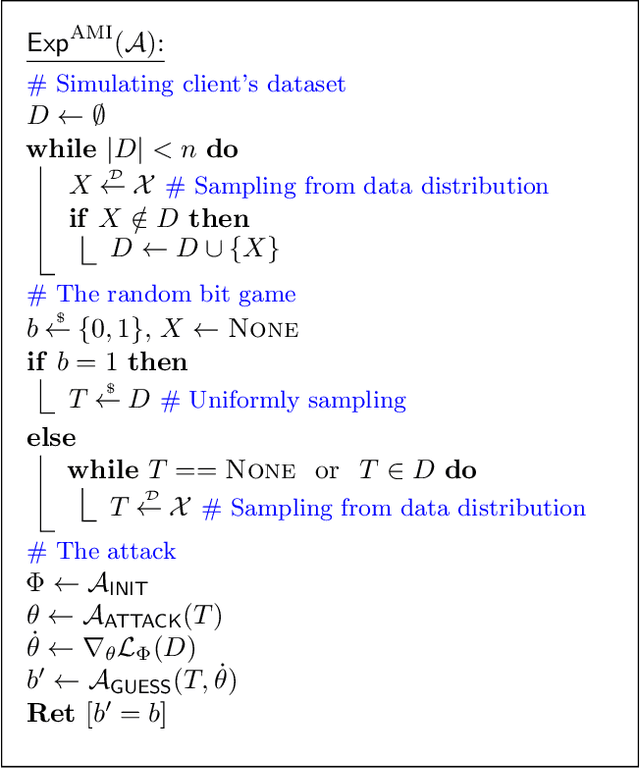

Abstract:With the rapid adoption of Federated Learning (FL) as the training and tuning protocol for applications utilizing Large Language Models (LLMs), recent research highlights the need for significant modifications to FL to accommodate the large-scale of LLMs. While substantial adjustments to the protocol have been introduced as a response, comprehensive privacy analysis for the adapted FL protocol is currently lacking. To address this gap, our work delves into an extensive examination of the privacy analysis of FL when used for training LLMs, both from theoretical and practical perspectives. In particular, we design two active membership inference attacks with guaranteed theoretical success rates to assess the privacy leakages of various adapted FL configurations. Our theoretical findings are translated into practical attacks, revealing substantial privacy vulnerabilities in popular LLMs, including BERT, RoBERTa, DistilBERT, and OpenAI's GPTs, across multiple real-world language datasets. Additionally, we conduct thorough experiments to evaluate the privacy leakage of these models when data is protected by state-of-the-art differential privacy (DP) mechanisms.
 Add to Chrome
Add to Chrome Add to Firefox
Add to Firefox Add to Edge
Add to Edge